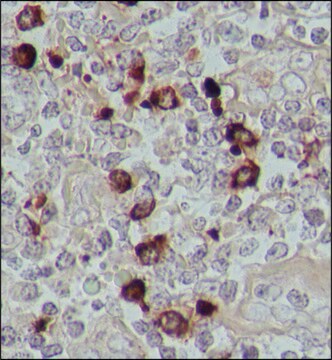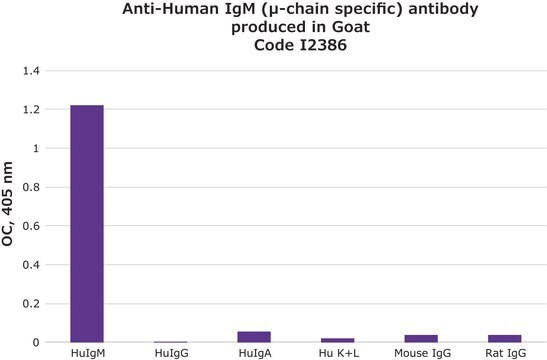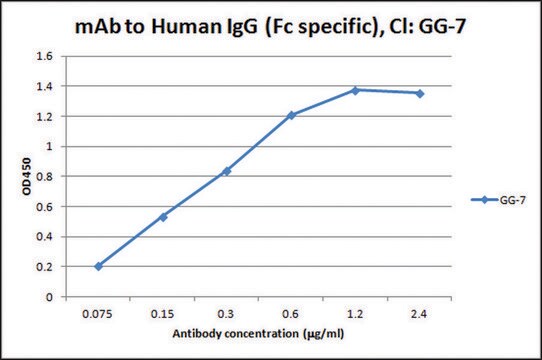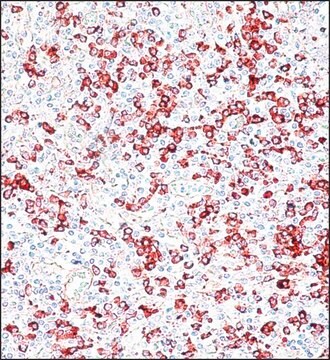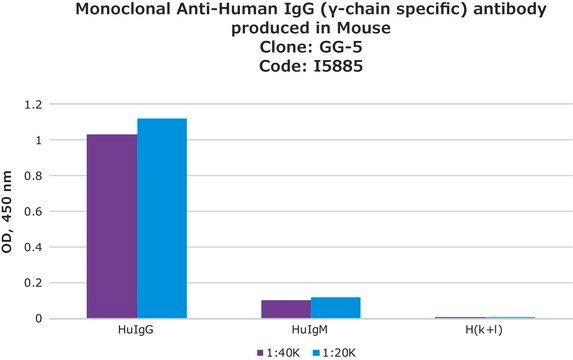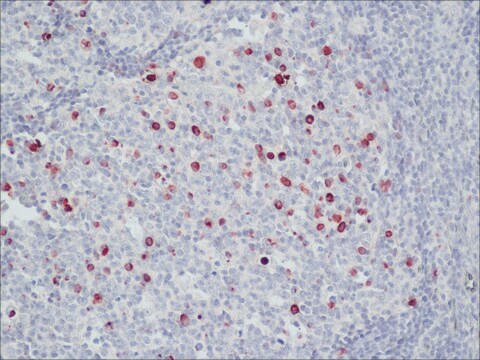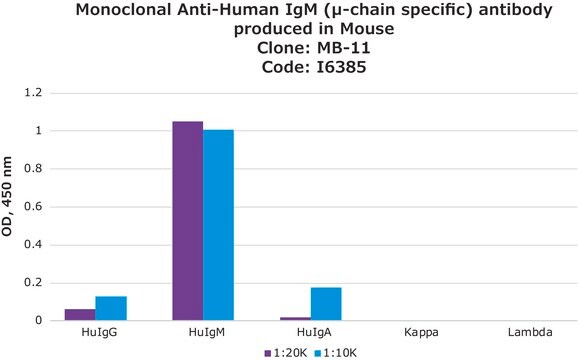推荐产品
抗體表格
purified from hybridoma cell culture
品質等級
抗體產品種類
primary antibodies
無性繁殖
GG-5, monoclonal
形狀
buffered aqueous solution
物種活性
human
濃度
~1 mg/mL
技術
indirect ELISA: 0.25-0.5 μg/mL using 5μg/mL human IgG for coating
同型
IgG1
運輸包裝
dry ice
儲存溫度
−20°C
目標翻譯後修改
unmodified
一般說明
Anti-Human IgG (γ-chain specific) antibody, Mouse monoclonal (mouse IgG1 isotype) is derived from the GG-5 hybridoma, produced by the fusion of mouse myeloma cells and splenocytes from mouse immunized with purified human IgG. Immunoglobulins (Igs) are produced by B lymphocytes and secreted into the plasma. Immunoglobulins can be divided into five main classes/isotypes which are IgA, IgD, IgE, IgG, and IgM. IgG class identity is determined by class-specific sequences in the Fc region of the heavy chain. IgG antibody class are the most abundant immunoglobulins isotype in blood, lymph fluid, cerebrospinal fluid and peritoneal fluid. IgGs include four subclasses (IgG1, IgG2, IgG3, and IgG4). The IgG subclasses differ in their physical and chemical properties. Their distribution pattern is found to be age dependent and every subclass has a specific biological function.
免疫原
purified human IgG
應用
Anti-Human IgG (γ-chain specific) antibody, Mouse monoclonal has been used in indirect ELISA.
生化/生理作用
Immunoglobulins (Igs) serve as key players in the humoral immune response.
外觀
Solution in 0.01 M phosphate buffered saline, pH 7.4, containing 15 mM sodium azide.
免責聲明
Unless otherwise stated in our catalog or other company documentation accompanying the product(s), our products are intended for research use only and are not to be used for any other purpose, which includes but is not limited to, unauthorized commercial uses, in vitro diagnostic uses, ex vivo or in vivo therapeutic uses or any type of consumption or application to humans or animals.
未找到合适的产品?
试试我们的产品选型工具.
儲存類別代碼
10 - Combustible liquids
閃點(°F)
Not applicable
閃點(°C)
Not applicable
其他客户在看
Patricia Colque-Navarro et al.
Clinical and vaccine immunology : CVI, 17(7), 1117-1123 (2010-05-07)
Serum samples from 151 healthy individuals aged from 15 to 89 years were investigated by enzyme-linked immunosorbent assay (ELISA) for IgG levels against 11 different purified antigens from Staphylococcus aureus. Surface antigens, such as teichoic acid, clumping factors A and
Maha Zohra Ladjemi et al.
The European respiratory journal, 45(4), 980-993 (2014-12-30)
Despite their relevance to mucosal defense, production of IgA and the function of lung B-cells remain unknown in chronic obstructive pulmonary disease (COPD). We assessed IgA synthesis in the lungs of COPD (n=28) and control (n=21) patients, and regulation of
N Ruijne et al.
Clinical and vaccine immunology : CVI, 13(7), 797-801 (2006-07-11)
Vaccine trials with infants enrolled between 6 and 10 weeks of age (young infants) and 6 and 8 months of age (older infants) provided an opportunity to evaluate immunoglobulin G (IgG) isotype distribution and avidity maturation as indicators of antibody
R Jefferis et al.
Annales de biologie clinique, 52(1), 57-65 (1994-01-01)
Secondary systemic immune responses are predominantly of the IgG class and passive administration of intravenous IgG, from pooled normal serum, is an effective prophylactic and/or therapeutic treatment for patients with defined immunodeficiencies. However, the proportions of each IgG subclass present
C B Reimer et al.
Hybridoma, 3(3), 263-275 (1984-01-01)
Stable clones of 31 mouse hybridomas that produce monoclonal antibodies (MAbs) against human IgG antigenic determinants were obtained. The number of hybridomas of different specificity described are: 2 anti-IgG1 Fc, 1 anti-IgG2 Fc, 1 anti-IgG2 Fd, 2 anti-IgG3 Fc, 2
我们的科学家团队拥有各种研究领域经验,包括生命科学、材料科学、化学合成、色谱、分析及许多其他领域.
联系技术服务部门

